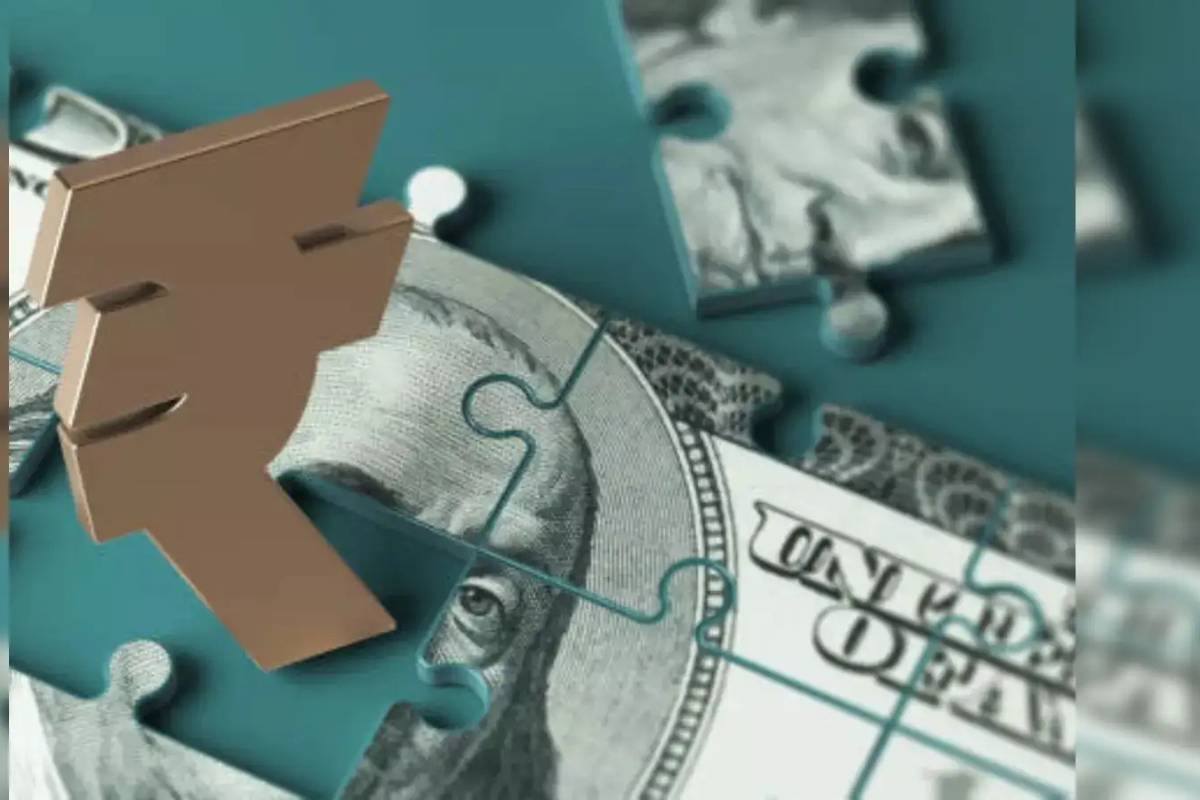On Friday, October 24, 2025, the Indian rupee rose by 10 paise to close at 87.78 against the U.S. dollar, a small but significant gain that gives the troubled currency some much-needed breathing room. This rise comes after weeks of the rupee having trouble breaking through important resistance levels. Currency traders and market watchers have been keeping a close eye on every move in what has been a very unstable year for the Indian unit.
The currency markets have been very hard to predict lately. The numbers in this movement are interesting, but so is the situation around them. The rupee has faced a lot of problems this year, like foreign investors pulling out and gold imports skyrocketing, but it has been very strong in the last few weeks, mostly because of the Reserve Bank of India’s smart actions.
Market Forces Behind the Movement
Traders say that Friday’s gains were due to a number of factors that made the flow of the rupee more favorable. The Reserve Bank of India has been working hard to control currency fluctuations. On Thursday and Friday, state-owned banks were seen selling dollars, but traders think these transactions weren’t necessarily done on behalf of the central bank. Even so, the RBI’s recent interventions near the 88 threshold have helped calm the markets and stop the big swings that were common in earlier months.
In October, foreign institutional investors became net buyers of Indian stocks, which was a welcome change from a worrying trend that had been going on for months. This change in capital flows has been very helpful for the rupee, even though there are still big problems in the economy as a whole. There is also growing hope for a trade deal between the US and India, which is another thing that is helping the local currency stay strong.
The price of crude oil has also been a factor. A drop in global oil prices makes it easier for India to pay for its imports. India gets about 80% of its crude oil from other countries, so this lowers demand for dollars and helps the rupee.
The RBI’s Defensive Strategy
The Reserve Bank of India hasn’t just been sitting around. Not at all. In just August, the central bank sold an incredible $7.7 billion in foreign currency to keep the rupee from falling too much. This was a big jump from the $2.5 billion it sold in July. The RBI always says that these interventions aren’t about targeting a specific exchange rate; they’re about controlling what officials call “excessive volatility.”
The RBI sells dollars to make more foreign currency available on the market. This can help slow down or even stop the rupee’s decline. In the short term, the plan works, but it does mean using up India’s foreign exchange reserves, which are an important safety net during economic shocks from outside the country. And let’s be clear: the RBI has been using these reserves wisely and with purpose, showing that it is committed to keeping the currency stable even while balancing other policy priorities.
The central bank has also been using USD/INR FX swaps to add liquidity to the rupee system. This is a technical move that helps with both currency stability and domestic liquidity needs at the same time. These actions, along with variable-rate repo actions worth $18.4 billion, show how complex the RBI’s approach has become.
Recent Performance and Volatility Patterns
All things considered, October has been a surprisingly good month for the rupee. The currency got stronger by about 0.28% over the month. It was trading around 88.06 per dollar on October 21, but by Friday, it had gotten even stronger, trading at 87.78. The INR/USD exchange rate ranged from 87.95 to 88.81 during the month. The rupee reached a one-month high thanks to support from the RBI and lower demand for dollars from importers.
Earlier this week, on Monday, October 20, the rupee rose 14 paise to 87.88, which was then called a one-month high. This was because foreign investors were putting money into the country, and crude oil prices were going down. It briefly reached 87.6350 against the dollar on Thursday, October 24, its highest point since late August. It then fell back a little and ended the day at 87.78. These changes show how volatile the forex markets are from day to day, but the overall trend since October has been slightly positive.
Persistent Challenges Weighing on the Currency
Even though the rupee has made some gains recently, it still faces big structural problems that won’t go away anytime soon. The currency is still down 4.72% from last year, which is a sign of bigger macroeconomic problems that go beyond short-term market changes. On Thursday, the rupee was trading at 23.92 per UAE dirham for Indian expats living in the UAE and other places. This was an improvement from 24.20 on October 9, but it still showed how the currency had been struggling all year.
The rupee is still under a lot of pressure to go down for several reasons:
- High tariffs on Indian exports, especially those put in place by the US government under President Donald Trump, have made investors feel bad
- When the President raised the tariff on Indian imports by 50% earlier in 2025, experts warned that it could make the country’s budget deficit worse and slow GDP growth by 60 to 80 basis points
- Foreign institutional investors have been selling a lot for most of 2025, which has kept the currency under pressure
- The rising price of gold has made India’s import bill much higher, which has put even more pressure on the currency and made the trade deficit bigger
Then there’s India’s real-effective exchange rate, which shows how much the rupee is undervalued or overvalued compared to inflation rates among India’s main trading partners. Analysts say this rate has dropped a lot lately. This technical indicator shows that the rupee’s problems aren’t just about short-term feelings; there are also basic economic problems that need to be fixed.
Global Context and Dollar Dynamics
You can’t understand how well the rupee is doing on its own. Within a global currency ecosystem, the U.S. dollar is still very strong, thanks to high U.S. bond yields and a Federal Reserve that has been careful not to cut interest rates too much. A strong dollar naturally draws money away from emerging markets like India, which keeps the USD/INR exchange rate going up.
The dollar index, which shows how strong the dollar is compared to a group of six other currencies, has stayed high all year. Even small changes in this index can have big effects on currencies in emerging markets, and the rupee is no different.
Asian currencies have been acting differently lately as traders get ready for important U.S. economic data releases, such as inflation numbers that will affect the Federal Reserve’s policy decisions. The markets have already factored in a 25-basis-point drop in interest rates by the Fed next week. However, ongoing tariff pressures could keep U.S. inflation high, making it hard for the Fed to cut rates in the future.
Trader Sentiment and Market Dynamics
Currency traders say that the current situation is one of cautious hope and constant uncertainty. Importers want to protect themselves from the dollar’s current level of about 87.78, which looks like a good time to buy. Exporters, on the other hand, seem more likely to wait, maybe hoping for the rupee to get stronger before they change their dollar earnings.
A dealer from a state-run bank said that Friday’s flow dynamics seemed better for the rupee, but he admitted that he didn’t know about any big transactions that had happened. In forex markets, it’s common for major players to work behind a veil of secrecy, and central bank actions aren’t always clear right away.
The USD/INR pair has been moving in what traders call a narrow range because U.S. policies, trade tensions, and global uncertainties are still making people feel bad. Forex experts say that exporters should think about options strategies that allow for market volatility. They know that capital outflows, high gold imports, and a general fear of risk around the world have all made the currency market more difficult.
Forecast and Future Trajectory
Analysts think the rupee will stay unstable through the end of 2025, depending on how the global economy and domestic policy change, the currency is expected to trade between 86.00 and 90.00 per USD. Trading Economics says that by the end of the year, the rupee will be around 87.75, which is very close to where it closed on Friday. It could go up to 86.78 over the next 12 months.
But other forecasting models, like those from LongForecast and Traders Union, think the value will slowly go down. They say this is because the U.S. dollar is strong, India’s trade deficit is growing, and there are geopolitical risks. Some people in the market are still cautious, and speculators are watching to see if the 90 per USD level could be broken if current pressures continue.
Technical Analysis Perspective
A trend-based Fibonacci extension that connects the low of 86.92 on August 19 with the high of 88.87 on September 25 shows that there is strong resistance at 88.85 and 89.60. Taking these things into account, the USD/INR could drop even more in the near future. This has led some currency experts to suggest that expats who want to send money to India should do so now, before the currency pair weakens even more.
Policy Implications and Strategic Considerations
Analysts say that the RBI will keep what they call an “asymmetric intervention strategy,” which means that it will stop sharp appreciation while letting gradual depreciation build up reserves. The central bank has to balance a lot of different goals, some of which may be at odds with each other:
- Keeping the currency stable
- Controlling inflation
- Making exports more competitive
- Having enough reserves
The rupee gets some support from India’s relatively high carry trade potential. As of October 2025, the RBI’s repo rate is 5.50%. This is higher than the rates of many other Asian countries, both in nominal and real terms. India’s policy rate would still be at the top end compared to its regional competitors, even if there is a 25-basis-point rate cut in the fourth quarter of 2025. This should keep some capital flowing into the country.
The rupee is getting more support because there is a better chance of a trade deal between the US and India in November. This could boost investor confidence and bring money into India from other countries. India’s exports to the United States make up about 18% of the total, which is twice as much as the 9% that goes to the UAE, which is the second-largest destination. Because of this, policy news from Washington will continue to affect the rupee’s short-term direction.
What This Means for Various Stakeholders
For Businesses in International Trade
Businesses that trade with other countries need to use advanced hedging strategies and keep a close eye on macroeconomic indicators in the current environment. Importers who have seen their costs go up and down a lot in 2025 might see the current level of around 87.78 as a chance to lock in forward contracts, which would protect them from the possibility of the rupee losing value. Exporters, on the other hand, have the opposite problem: a weaker rupee helps them, but too much volatility makes it very hard to plan and set prices.
For Indian Expats Sending Remittances
People from India who send money home have been especially interested in how the rupee has been changing. The recent rise from a low of 87.78 to a high of 88.87 is a significant improvement in the value of their remittances. Currency experts say that the current levels may be a good time for remittances because of the technical resistance levels ahead and the chance of renewed weakness.
For Foreign Institutional Investors
The rupee’s path is only one of many things that foreign institutional investors have to think about when making an investment decision. Even though the currency has stabilized a bit, the 4.72% drop from last year to this year is bad news for dollar-based investors. The recent change to net buying in October shows that some people are starting to feel better about things, but these flows can change quickly depending on how people feel about global risk and how much they expect to make in relative terms.
The Broader Economic Picture
The rupee’s value changes are a sign of India’s overall economic health and its place in the world economy. A growing trade deficit, mostly because of energy imports, keeps the structural demand for dollars high. Imports of gold, which have gone up because prices have gone up, add to this pressure. India is one of the biggest gold consumers in the world, so when prices go up, the bill for imports goes up too.
These problems are made worse by geopolitical risks and uncertainty about global trade policies. In 2025, the world economy is still unstable. Trade tensions, policy uncertainty, and changing alliances make it easy for capital flows to change direction quickly. India has a big, open economy that relies on foreign investment and trade. This volatility puts pressure on the currency.
But there are reasons to be cautiously hopeful:
- India’s economy continues to grow at a pace that many developed nations would like to have
- The domestic stock market has been strong, even though there have been times when foreign investors have pulled out
- The RBI’s proactive management of currency volatility shows that it has the ability and will to keep things stable
Navigating Uncertainty
Analysts say that policymakers have a hard job: they need to support the currency without stopping growth. Aggressive intervention to support the rupee can use up foreign exchange reserves and make it harder to change monetary policy. On the other hand, letting the currency drop too much causes inflation by making imports more expensive and can cause capital flight.
The RBI’s actions so far seem to be a middle ground: they step in to smooth out volatility and stop panic, but they also let the currency depreciate slowly, which keeps exports competitive and doesn’t waste reserves. The Federal Reserve’s policy path, commodity prices, geopolitical events, and the unpredictable world of investor sentiment all play a role in whether this strategy can be maintained.
Friday’s 10-paise rise to 87.78 is, in one way, just another piece of information in the never-ending flow of currency movements. But it also means something else: a brief period of stability and a small victory in the ongoing effort to manage India’s entry into unstable global financial markets. These small changes are important for traders, businesses, policymakers, and regular people sending money home. They are the building blocks of economic confidence and the best way we have to see how the world sees India’s economic future






















